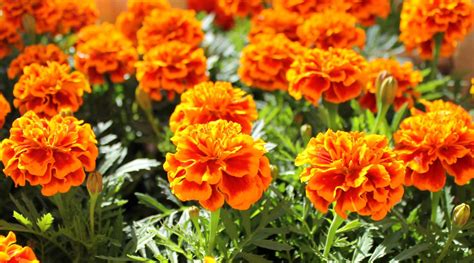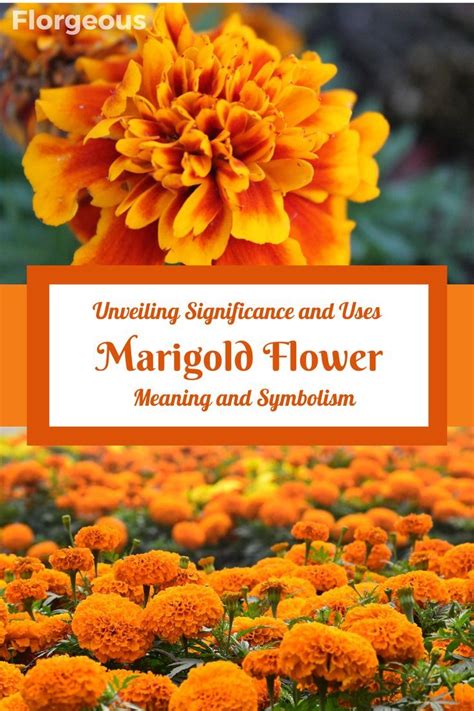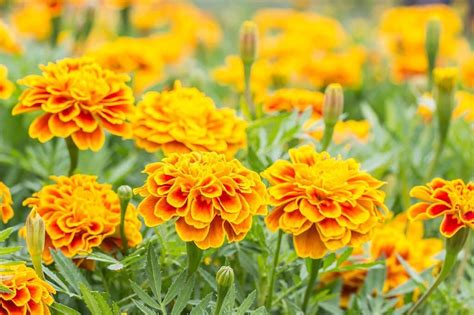As the sun rises and casts its warm rays upon a field of splendid blooms, it is impossible not to be captivated by the radiant allure of vibrant golden marigolds. These stunning flowers possess a profound symbolism that has fascinated cultures across the globe for centuries. Revered for their mesmerizing beauty and mystical essence, marigolds have woven themselves into the tapestry of human existence, symbolizing diverse emotions, beliefs, and rites of passage.
Joy, happiness, and the warmth of the sun: Though dubbed by various names in different regions, golden marigolds consistently evoke a sense of exuberance and delight. Their mesmerizing hue, reminiscent of the golden sunlight, fills the hearts of onlookers with a sense of happiness and warmth. In many cultures, the vibrant yellow petals of marigold flowers have become synonymous with joyous celebrations and festivals, infusing an atmosphere of merriment and bliss. Their unmistakable radiance serves as a reminder to embrace the simple pleasures of life and to bask in the sunshine of positivity.
Protection, spiritual cleansing, and guiding the departed: Beyond their visual splendor, marigolds have also found a place in the realms of protection and spiritual practices. In certain traditions, these golden treasures are considered powerful guardians against evil spirits and negative energies. They are believed to possess the ability to purify the surrounding environment, clearing away any malevolent forces that may dwell within. Moreover, marigolds are associated with guiding the souls of the departed towards the afterlife, acting as beacons of light amidst the darkness.
Symbolism of passion and love: Marigolds, with their fiery yellow petals, have long been linked to matters of the heart. Their vibrant hue is often associated with passion, desire, and love. In some cultures, marigolds are used in romantic rituals and gifts, symbolizing the intensity of emotions between two individuals. These golden blooms are thought to ignite flames of desire and kindle the spark of love, their enchanting beauty serving as a testament to the fiery depths of the heart.
The History and Origins of Marigolds

Exploring the rich past of marigolds unveils fascinating insights into their origins and the significant role they have played throughout history. This article delves into the extensive history of these vibrant flowers, highlighting their cultural, symbolic, and medicinal significance.
Historical Significance
Marigolds have been revered since ancient times, with references to their cultivation dating back centuries. Cultures around the world have recognized the captivating beauty and versatility of these flowers, incorporating them into various traditions and rituals.
Cultural Diversity
Marigolds hold a special place in the hearts and customs of diverse cultures worldwide. They have been used in religious ceremonies, weddings, and other significant events as symbols of love, purity, happiness, and prosperity. These flowers have also been valued for their ability to ward off evil spirits and bring good luck.
Medicinal and Healing Properties
Marigolds have long been cherished for their medicinal properties, offering a range of health benefits. They are known for their anti-inflammatory, antioxidant, and antimicrobial properties, making them a popular ingredient in traditional medicine. These flowers have been used to soothe various ailments, including digestive issues, skin conditions, and inflammation.
Symbolic Meanings
Marigolds are imbued with symbolic meanings and interpretations across cultures. They are often associated with the sun, representing warmth, energy, and optimism. Additionally, these flowers symbolize creativity, passion, and abundance, capturing the essence of vibrant and dynamic qualities.
In conclusion, exploring the history and origins of marigolds provides a captivating journey into their cultural significance, healing properties, and symbolic meanings. From ancient rituals to modern-day uses, these flowers continue to capture the hearts of people around the world, adding beauty and vibrancy to various occasions and settings.
Exploring the Ancient Origins of Lively Golden Blossoms
Delving into the history of vibrant golden blooms, we uncover a wealth of ancient roots that give meaning and significance to these marvelous flowers. Embarking on a journey through time, we unravel the captivating tales and cultural connections that have shaped the symbolism of these resplendent yellow blossoms.
- Discovering Ancient Civilizations: From the ancient civilizations of Egypt and Mesopotamia to the Indus Valley and beyond, vibrant yellow blooms have long held a place of reverence and significance. Exploring the scriptures, artwork, and historical records left behind, we gain insights into the meanings attributed to these radiant floral wonders.
- Nature's Golden Elixir: Consistently revered for their medicinal properties, vibrant yellow blooms have been utilized for centuries across different cultures for their natural healing abilities. Uncover the ancient wisdom and practices associated with these marvelous flowers, as they were used in treatments, herbal remedies, and spiritual rituals.
- A Symbol of Light and Prosperity: Beyond their aesthetic appeal, vibrant yellow blooms have symbolized light, happiness, and prosperity in various cultures throughout history. Dive into the belief systems and folklore that have intertwined with these blossoms, offering hope, joy, and abundance.
- Cultural and Spiritual Significance: From ancient rituals and ceremonies to religious symbolism and cultural traditions, vibrant yellow blooms have played a significant role in many societies. Explore the diverse ways in which these flowers have been integrated into celebrations, rites of passage, and spiritual practices.
- An Ode to Nature's Brilliance: Finally, marvel at the sheer beauty and vibrancy of these golden blossoms. Delve into the poetic expressions and artistic representations that have sought to capture the essence of these captivating flowers, celebrating their radiant allure in various forms of creative expression.
Join us as we embark on an enlightening exploration into the ancient origins of vibrant yellow blooms, unearthing the diverse meanings and symbolism that have made these marigolds a beloved presence throughout history.
Unveiling the Cultural Significance of Marigolds

Exploring the deep-rooted cultural symbolism of marigolds, this section examines the profound significance these flowers hold in various cultures around the world. Delving into the rich tapestry of traditions and beliefs associated with marigolds, we uncover the diverse cultural meanings and rituals that have been passed down through generations.
Latin America: In Latin American countries, marigolds are closely tied to celebrations of the Day of the Dead. These vibrant flowers are believed to guide the spirits of loved ones back to the world of the living during this annual festival. They are often used to decorate altars and graves, creating a vivid and colorful tribute to honor the departed. | India: In Indian culture, marigolds are widely revered and hold great spiritual significance. These flowers are considered sacred to Hindu deities and are used extensively in religious ceremonies, weddings, and festive occasions. The vibrant hues of marigolds are believed to bring good luck, happiness, and prosperity. |
Mexico: In Mexico, marigolds are an integral part of the famous Dia de los Muertos celebrations. With their bright orange and yellow petals, marigolds are believed to attract the souls of the deceased during this vibrant and joyous occasion. These flowers are used to create intricate floral arrangements and altars, symbolizing a welcoming path for departed spirits. | China: In Chinese culture, marigolds hold associations with fortune and prosperity. They are often used during celebrations such as the Chinese New Year and weddings to bring good luck and ward off evil spirits. Marigolds are also believed to possess innate healing properties and are used in traditional medicine practices for their medicinal benefits. |
Across different cultures, marigolds evoke a sense of vibrancy, joy, and spiritual significance. By understanding the cultural importance of these flowers, we gain a deeper appreciation for their symbolism and the role they play in various ceremonies and traditions worldwide.
From Celebrations to Mourning: Marigolds in Global Traditions
Marigolds have long held significance in numerous cultures around the world, representing a wide range of emotions, customs, and traditions. From joyous celebrations to somber funerals, these vibrant flowers have etched themselves into the tapestry of global traditions.
One of the most prevalent uses of marigolds is during festive occasions. In many cultures, these flowers symbolize happiness, warmth, and good fortune. They are often featured prominently in vibrant decorations and garlands during festivals, bringing joy and color to the celebrations. Whether it's the Day of the Dead in Mexico or the Hindu festival of Diwali in India, marigolds take center stage, infusing the festivities with their radiant beauty.
However, marigolds also play a significant role in more solemn events, such as funerals and memorials. In some cultures, these flowers symbolize sorrow, grief, and remembrance. Their subtle fragrance and delicate petals bring comfort and solace to mourners, serving as a reminder of the fleeting nature of life. Whether adorning graves or woven into funeral wreaths, marigolds provide a poignant touch to honor those who have passed away.
Interestingly, marigolds have also found their way into medicinal practices in various cultures. The vibrant blooms are believed to possess healing properties and are used in traditional remedies to treat ailments ranging from digestive issues to skin problems. Their bright color is often associated with vitality and well-being, making them a popular choice for herbal remedies and holistic healing practices.
Furthermore, marigolds have symbolized bravery and courage throughout history. In certain traditions, warriors would wear garlands made of marigold flowers before heading into battle, to invoke strength and protection. The bold yellow and orange hues of the marigolds were believed to ward off evil spirits and bring good fortune in challenging situations.
From joy to sorrow, from celebrations to mourning, marigolds have transcended cultures and continents, embodying a myriad of meanings and symbolism along the way. Whether used as decorative accents, healing remedies, or symbols of bravery, these vibrant flowers continue to captivate and inspire individuals around the globe.
The Significance of Lively Golden Marigolds

Exploring the rich symbolism behind the vibrant hue and blooming essence of the marigold flower opens up a world of profound meaning and ancient associations. This article delves into the significance of the golden marigold and its timeless role in various cultural contexts, shedding light on the symbolism that it holds for different aspects of human existence.
An Illuminating Glow
The resplendent golden hue of marigolds serves as a powerful representation of vitality, vibrancy, and positivity. This radiant color evokes a sense of warmth and joy, capturing attention and filling a space with an uplifting ambiance. In various cultures, this vivid shade of yellow is deeply intertwined with notions of happiness, illumination, and enlightenment.
A Beacon of Courage
Alongside their captivating hue, marigolds are also admired for their strong and sturdy nature. This resilience is often associated with bravery, protection, and overcoming adversity. Just as these vibrant blossoms confidently face the elements, they inspire individuals to embrace challenges with courage and determination, instilling a sense of inner strength that helps navigate through life's obstacles.
An Offering to the Departed
In certain traditions, marigolds hold great significance in honoring and remembering loved ones who have passed away. The yellow blooms are often used as offerings during religious or spiritual ceremonies, symbolizing not only the beauty of life but also the connection and continuity between the living and the deceased. These marigold tributes serve as a gentle reminder to cherish memories and pay homage to those who have left a lasting impact on our lives.
An Emblem of Prosperity
Marigolds are known to be associated with prosperity and abundance in various cultures around the world. Their vibrant blooms are believed to attract good fortune and bring about success and wealth. This symbolism extends beyond material wealth and encompasses the concept of overall prosperity, encompassing aspects such as happiness, good health, and spiritual fulfillment. As such, marigolds are often incorporated into celebrations and rituals that aspire to invite prosperity into people's lives.
With their striking golden hue and profound symbolism, marigolds continue to captivate and inspire individuals across different cultures and time periods. Whether perceived as a beacon of joy and illumination, a symbol of courage and resilience, an homage to the departed, or an embodiment of prosperity, these lively flowers hold a place of great significance in the human collective consciousness.
Delving into the Significance of the Luminous and Exquisite Blooms
Embark on a captivating journey exploring the profound meaning encapsulated by the resplendent marigold flowers. Steeped in ancient traditions and revered across cultures, these vibrant blossoms hold a rich tapestry of symbolism that transcends language barriers and enchants the human spirit.
When we immerse ourselves in the essence of these magnificent petals, we unearth a world of hidden significance. Their brilliance is not merely a result of their captivating hues, but rather a reflection of the joy, warmth, and positivity they represent. As if touched by the divine, marigolds impart a sense of radiance that brightens the darkest of days, rejuvenates weary souls, and beckons us to embrace life's bountiful beauty.
Symbolizing various virtues and concepts, the marigold has deep roots in mythology, folklore, and spirituality. Its fiery petals evoke the virtues of courage and resilience, bestowing upon us the strength to overcome challenges and persevere in the face of adversity. Furthermore, these blossoms possess a transformative power, reminding us to embrace change, shed the old, and embrace the new beginnings that await us.
Moreover, the marigold's stunning presence extends beyond its visual allure. With its distinct fragrance, it captivates our olfactory senses and invokes nostalgia, memories, and emotions of the past. Its scent lingers in the air, whispering tales of love, celebration, and remembrance, making marigolds an integral part of rituals and festivities.
The significance of marigolds extends beyond their aesthetic charm; they are treasured for their medicinal properties as well. Known for their antibacterial and antifungal properties, these radiant blooms have long been revered in traditional medicine, offering remedies for various ailments and soothing both the body and the mind.
In conclusion, the marigold's vibrant presence and profound symbolism illuminate our lives with their beauty and meaning. They serve as a reminder to embrace the qualities they embody - courage, resilience, joy, and transformation. As we unravel the layers of significance hidden within these bright and beautiful blossoms, we embark on a journey of self-discovery, spiritual enlightenment, and a deeper understanding of the interconnectedness of all living beings.
FAQ
What is the meaning of vibrant yellow marigolds?
Vibrant yellow marigolds represent joy, happiness, and optimism. Their bright and cheerful color is often associated with the sun and its life-giving qualities.
Are marigolds considered a symbol of good luck?
Yes, marigolds are often considered a symbol of good luck. In some cultures, they are believed to ward off evil spirits and bring fortune and prosperity to the home.
Can marigolds have a deeper symbolic meaning in different cultures?
Absolutely! In Mexican culture, marigolds are strongly linked to Dia de los Muertos (Day of the Dead) and are used to honor and remember deceased loved ones. In Hindu tradition, marigolds are associated with celebrations and are often used in religious ceremonies and decorations.



